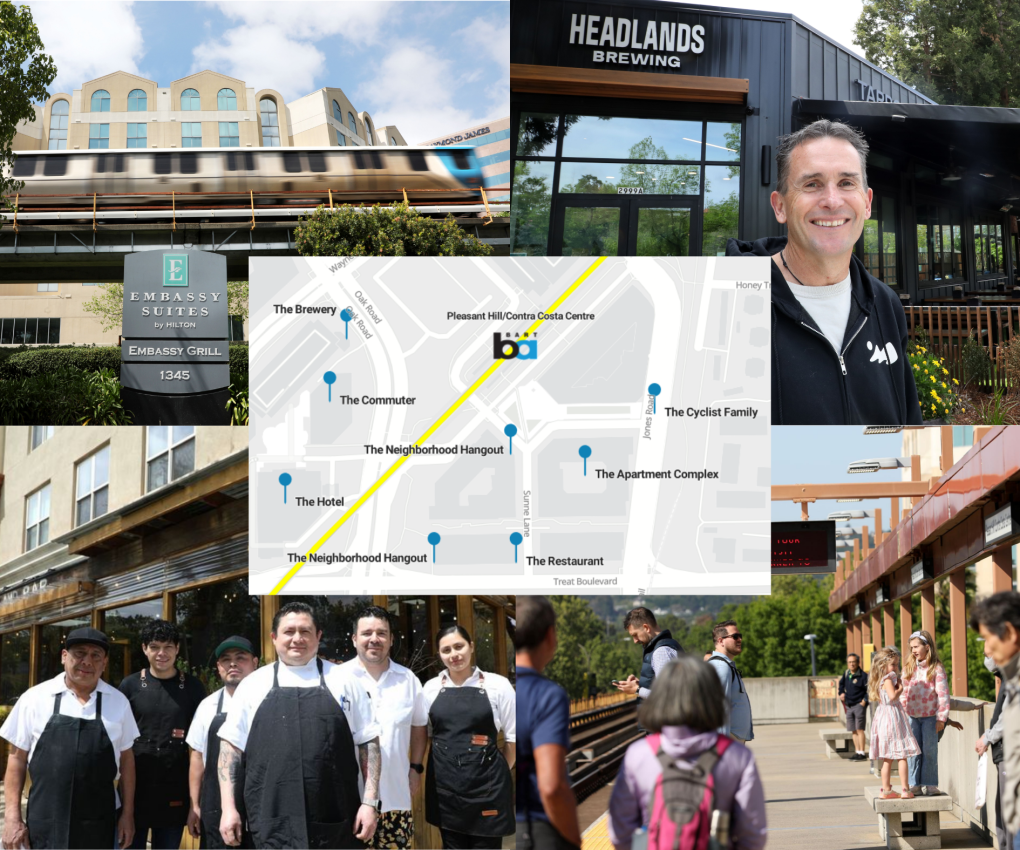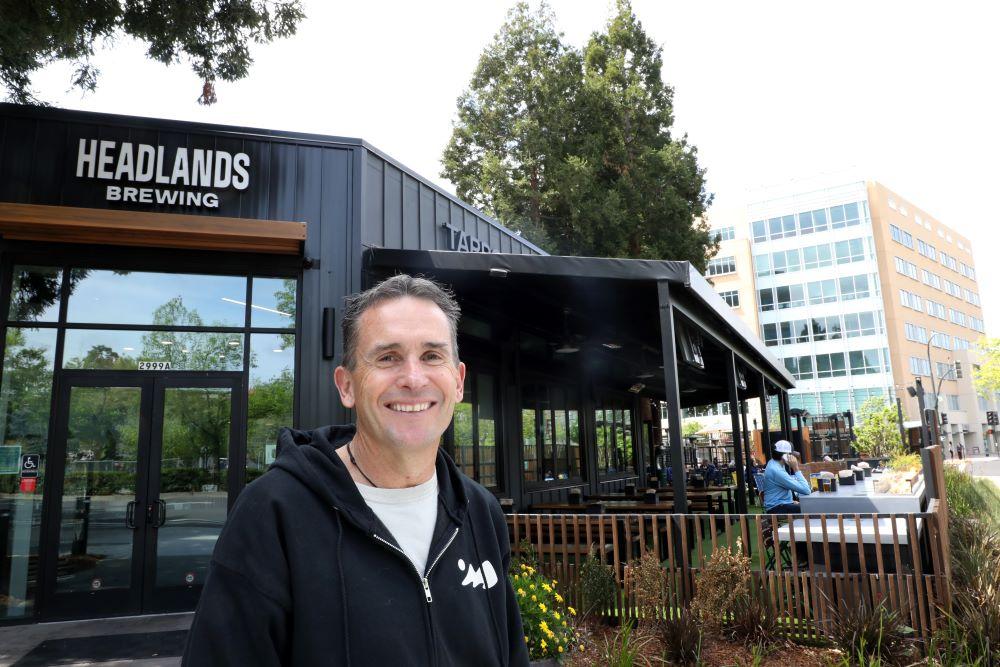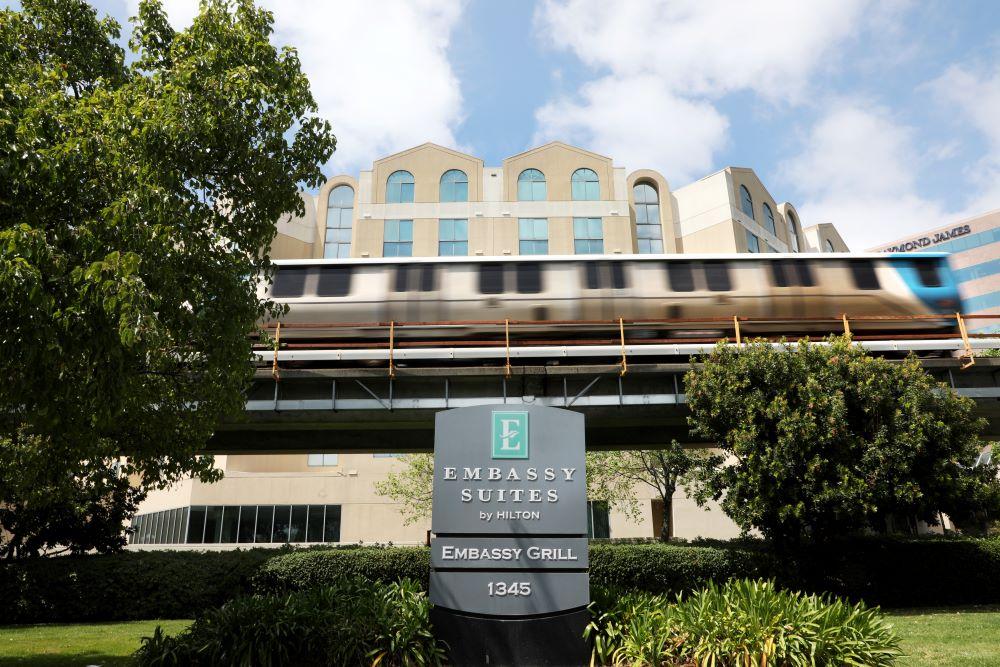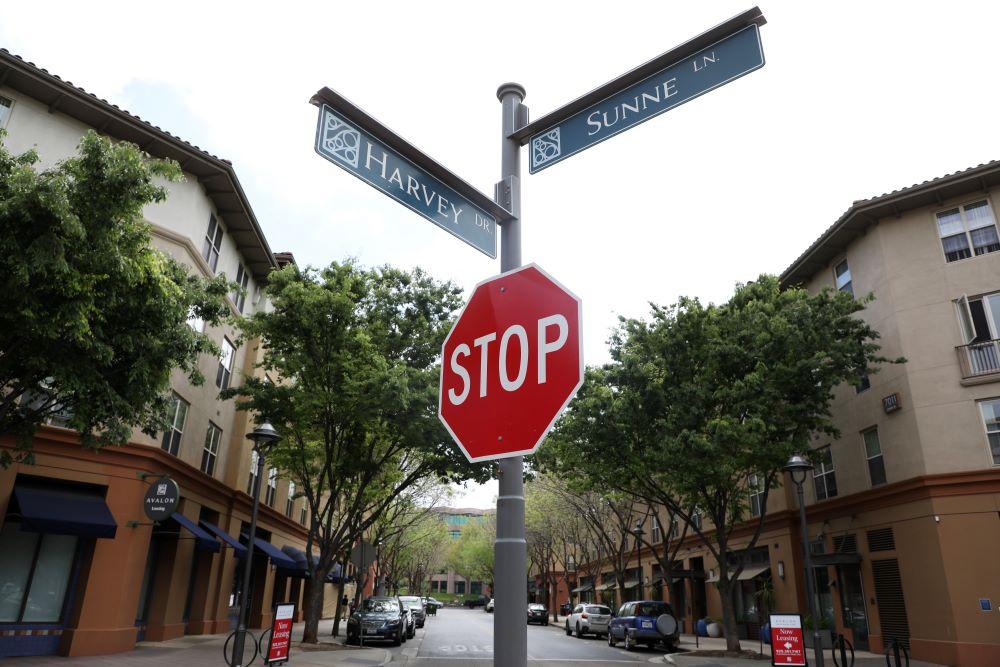How one BART station supports a city’s ecosystem of businesses, residents, and tourists

View an interactive map of some of the businesses, places, and people that contribute to the neighborhood's economic and cultural vibrancy
How do you measure BART's impact on the Bay Area?
You might look at the numbers. In fiscal year 2024, for example, BART contributed an estimated $2.7 billion in economic activity to the five counties it serves. Another metric: Riders traveled over 750 million miles that same year* – that's nearly a billion miles traveled on our tracks!
But other impacts go beyond stats and figures: BART makes people’s lives easier, BART reduces traffic, BART helps the environment. Numbers don't tell the whole story.
So, where to begin? Let's start small.
To understand BART’s impact, we will start by looking at a single station – Pleasant Hill/Contra Costa Centre. From this zoomed-in vantage point, we can illustrate how just one station transforms and sustains not just a neighborhood, but a broad community of residents, workers, businesses, travelers, and families.
Pleasant Hill/Contra Costa Centre Station sits at the convergence of Highway 680, the Iron Horse pedestrian and bicycle trail, multiple hotels and office buildings, and a vibrant mixed-use transit village with restaurants, gyms, bars, a dance school, 600-plus apartment complex, the list goes on . The station is the beating heart that enables these resources to exist and prosper. BART stations are not simply destinations -- stops on a line to get you here and there.
BART stations create destinations.
We connected with local homeowners, small business owners, a commuter, a major hotel chain, restaurants, neighborhood hangouts, and an apartment complex to understand firsthand why BART is essential to their bottom lines and the well-being of their community.
Hear what they had to say in the interactive map below or view the map in a new tab by clicking here.
By looking at this single station – one of fifty – we begin to understand why public transportation is so crucial to the Bay Area. The impact of one station is immense; imagine the impact of all of BART’s 50 stations taken together! Public transportation facilitates economic growth and livable communities, and that equates to a booming region that will grow and flourish for generations to come.
“Locating by a BART station is a great move for businesses,” said BART Director Matt Rinn, whose district includes Pleasant Hill/Contra Costa Centre Station. “You have in-built customers, who are coming and going from the station, you can increase capacity by not needing a parking lot, and your employees can get to work affordably.”
Rinn knows business. He opened his insurance agency in Pleasant Hill and was named the city's Businessperson of the Year in 2011. He learned the role transit plays in sustaining and building communities when he was elected to the Pleasant Hill City Council and became a board member on the Pleasant Hill Chamber of Commerce, for which he later served as Chairman of the Board.
“These experiences helped me understand and appreciate how vital transit is to our communities. It builds a vibe. BART has helped attract a demographic that wouldn’t necessarily settle in the suburbs – young families, people who work in tech – who can experience all the amenities of a suburban environment, including more housing options, but can easily commute into major urban centers for work.”
- BART Director Matt Rinn
*Calculated with the APTA Economic Impact Tool
The New Brewery in Town

“BART and breweries go hand in hand. Promoting ‘Ride BART to Headlands Brewing’ is a key part of our marketing strategy."
- Austin Sharp, CEO Headlands Brewing
The new kid on the block in the Contra Costa Centre Transit Village is Headlands Brewing, the third East Bay outpost of the craft beer brewery.
The family-friendly beer garden, set amongst tall redwoods with fire pits and a kids’ play area, opened in March 2025. For the grand opening, Headlands offered $1 off your first pint when you showed your Clipper card.
“Proximity to BART was key” in choosing the location, CEO Austin Sharp said. “It’s by far the easiest way to get to our location.”
Transit accessibility isn’t important just for Sharp’s customers, but his employees too. Headlands recently launched commuter benefits for its employees. All of Headlands’ locations are BARTable, including its main brewery in Pittsburg (it’s closed to the public).
The Cycling Family
“We moved to our neighborhood because it’s close to Pleasant Hill/Contra Costa Centre Station. One hundred percent. I wanted to live by BART to open up job opportunities so I wouldn’t have to drive."
- Kristin Tennessen, Walnut Creek Resident
“A community is built by interacting in a positive way,” said Kristin Tennessen, whose family of five lives a short bike ride from Pleasant Hill/Contra Costa Centre Station. “Bicycling on the trail system here has made facilitating those connections easy.”
To get to work each morning, Tennessen and her husband ride their bikes along the Contra Costa Canal Trail to the station – it takes about eight minutes – lock their bikes up, and ride BART to their offices. They also regularly ride their bikes to BART with their kids, ages six, nine, and eleven, to take them on various adventures, like the Oakland Museum of California and the Exploratorium.
“People in their cars can’t stop and talk to each other like you can on a bike,” Tennessen said. “I run into people on the trail while I’m heading to BART, and we stop and chat. It facilitates interaction with your community.”
The Restaurant
“People live here because BART is here, and that brings us business. We complement each other."
- Giorgio Palacios, General Manager of Parada
Ten years ago, Peruvian restaurant Parada opened on the corner of Treat Boulevard and Sunne Lane. One of the main reasons for selecting the sunny corner spot: its proximity to BART.
“It’s very common for customers to take BART here from Antioch, from Concord, from Oakland,” said Giorgio Palacios, Parada General Manager. “Employees take BART, too, especially the younger people who don’t want to worry about their parents picking them up at the end of their shift.”
Parada is known for its succulent pisco sours, “and because we serve alcohol, we want to make sure our customers are safe and can get home without getting in trouble.”
The restaurant group, Altamirano, owns two other BARTable restaurants: Sanguchon Eatery in San Francisco’s Mission District and Barranco in Downtown Lafayette.
The Hotel

"One of the key benefits of staying with Embassy Suites Walnut Creek is its location across the street from a BART station. Guests rave about it. They love that they can skip the hassle of renting a car and just take BART."
- David Burri, Director of Sales and Marketing, Embassy Suites – Walnut Creek
It’s not uncommon for travelers to discover Embassy Suites in Walnut Creek by googling, “hotels near BART,” said David Burri, Director of Sales and Marketing, Embassy Suites – Walnut Creek.
“Our location is just a four-minute walk to BART. It's a huge selling point for groups, conventions, and individual travelers, especially because it’s an easy trip from the San Francisco and Oakland airports,” he continued. “That’s one of the first things we discuss with people interested in hosting conferences and events at the hotel – BART is right here, and it makes it simple to travel back and forth to San Francisco, Oakland, and local attractions.”
Burri said he has posters in the hotel lobby that promote using BART, and it’s one of the first conveniences mentioned on the hotel’s website and promotional material.
“Our Guest Services team gets a lot of questions about how to travel to local attractions: What’s the fastest way to the Moscone Convention Center? How do I get to Fishermen’s Wharf?” Burri said. “We always encourage them to skip the traffic and take BART.”
The Commuter
"Taking BART versus driving gets me to my office so much faster. If I’m driving during commute hours, four to five miles can take up to 45 minutes. It takes a long time to even get to the highway."
- Michael Blasky, daily commuter
Every weekday, Michael Blasky takes BART from his home in Concord to his office in the Contra Costa Centre Transit Village.
“BART gets me to my office so much faster than driving,” said Blasky, who works for the Contra Costa County Transportation Authority. “The road infrastructure is pushed to the max for commuters here. If you’re taking the local highways or the thorough streets through Contra Costa County, you’re going to be backed up in traffic.”
Blasky said his commute is also “essentially free” because the Contra Costa Centre Transit Village offers significant commuter benefits, like $80 on a Clipper card for $5.
“My wife and I were considering buying an electric car when I got this job, but because of the commuter benefits program, it made absolutely no financial sense," Blasky said.
The Neighborhood Hangouts
"BART is a convenient way for people not to drink and drive. When customers take BART, they can fully enjoy what we have to offer."- Baldeep Sangha, co-owner of Hops & Scotch and Bill & Bali's
Baldeep and Gurpreet Sangha own two businesses by the station – the bar Hops & Scotch and the pizza-and-pints place Bill & Bali's. They're just around the corner from each other.
“The BART station and the location itself were the biggest draws for us,” he said. “And then all the Avalon residents upstairs. There’s in-built community here.”
After work, people will walk over from BART to grab a quick drink with friends at Hops & Scotch or pick up their kids for some fresh slices at Bill & Bali's. It's a nice alternative to having to schlep into downtown, Sangha said.
“There’s a lot of foot traffic here, so we get a good deal of exposure,” he concluded. “If the BART station disappeared for whatever reason, that would significantly hurt our pocketbook.”
The Apartment Complex

"I had a blast living at Avalon Walnut Creek. It’s located right next to Pleasant Hill [Contra Costa Centre] Station, which makes the commute into the city as convenient as it can be on BART."
- Piotr G., former Avalon resident (via Yelp)
Avalon Walnut Creek is a shining example of transit-oriented development, a form of urban development that concentrates high-density, mixed-use development by public transit stations.
The community features over 600 apartment homes, including affordable housing, just steps from the BART station.
“The people who live here value accessibility to public transit and walkability,” said Katrina Gaasterland, Community Manager at AvalonBay Communities. "We get a lot of feedback from prospective residents that BART is one of the highlights for leasing in our community. They use it to get to work and entertainment, and it cuts down on costs associated with owning a vehicle. Plus, it’s just easy!”
